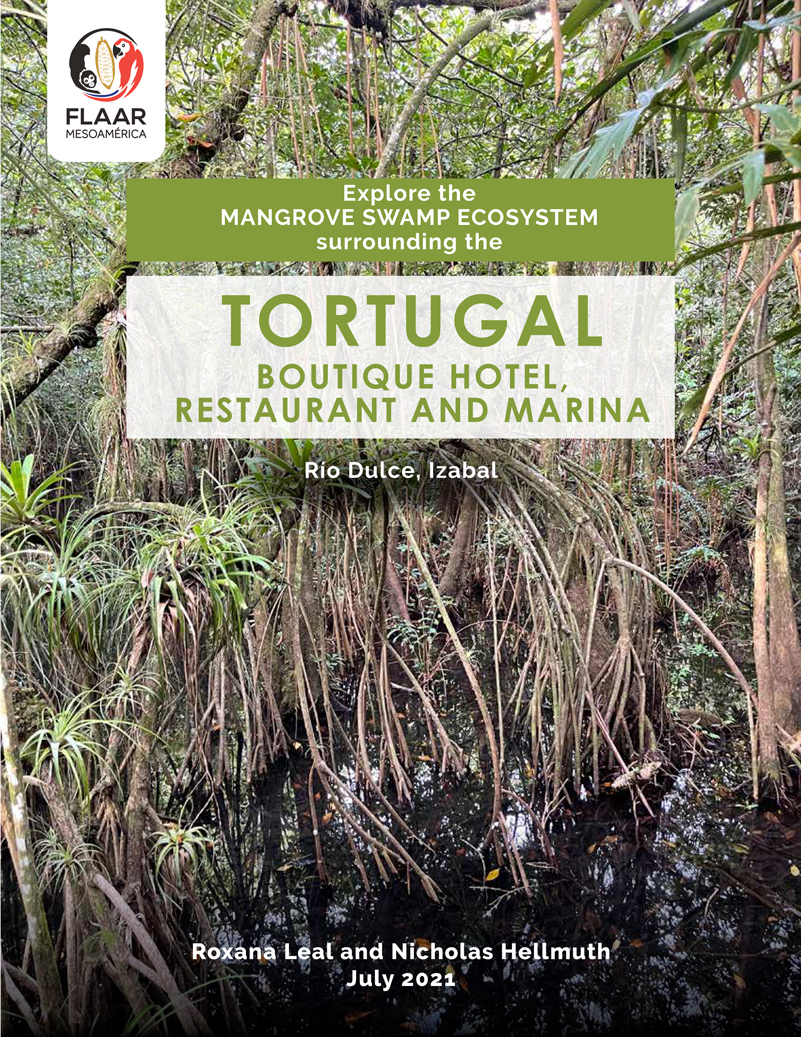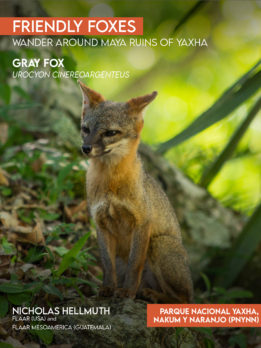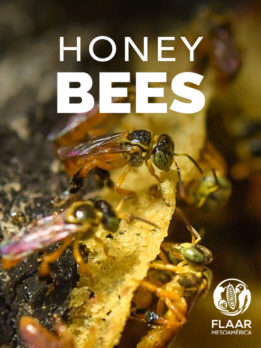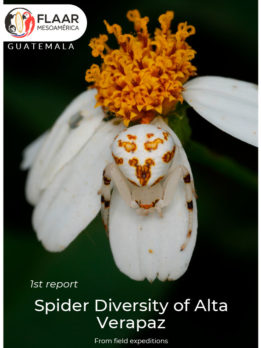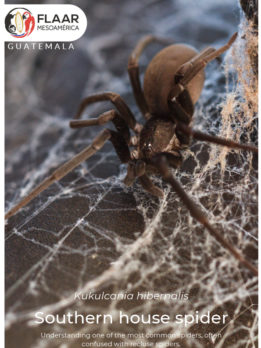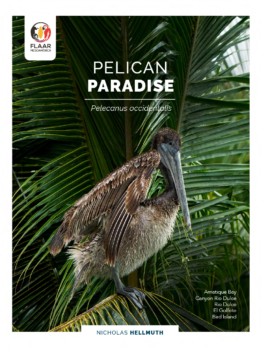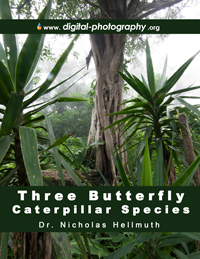Lots of Howler monkeys to see and photography in Parque Nacional Yaxha, Nakum and Naranjo
As you hike through the Yaxha areas of PNYNN you will often see both spider monkeys and howler monkeys. If you spend the night in Ecolodge El Sombrero, at the entrance to the park, there are howler monkeys roaring over your bungalow several times in the day and early morning.
Lots of monkeys in Parque Nacional Tikal, and Estación Biológica Las Guacamayas (Rio San Pedro, Peten).
In several months of field work in Izabal forests we have heard a howler monkey only twice (in Peten you hear dozens every day all year). We are surprised there are so few monkeys in the nature reserves of the Municipio de Livingston.
Alouatta palliata, the Mantled Howler Monkey
Our team is also preparing a separate annotated bibliography on Alouatta palliata, the Mantled Howler Monkey. This rare species is found in Veracruz, Tabasco and nearby Mexican areas; and in Izabal (Guatemala) to adjacent Honduras and then all the way south to northern Peru. None of the local people that we work with in Izabal have seen this; yet it is present nearby.

Photograph by Erick Flores, with a Canon EOS-1D X Mark II, EF300mm f/2.8L IS II USM lens. 1/400 sec, f/4.0, ISO 640
Bibliography, books, articles, web sites: List of Suggested Reading on
Howler Monkeys, especially of Guatemala and
surrounding countries of Mesoamerica
This bibliography is the work of Nicholas Hellmuth, Vivian Hurtado, Marcella Sarti and Linda Bac.
- 1991
- Los mamíferos de Chiapas. Gobierno del Estado de Chiapas, Consejo Estatal de Fomento a la Investigación y Difusión de la Cultura, DIF-Chiapas, Instituto Chiapaneco de Cultura, 133 pages.
This opus is missing from the bibliography on howler monkeys that we found on-line. Alvarez del Toro focused on mammals of Chiapas, spiders of Chiapas, butterflies of Chiapas, and reptiles of Chiapas. Would be wonderful to have books of this nature on each kind of creature in Peten (probably over 80% of the creatures at Parque Nacional Yaxha Nakum Naranjo (PNYNN) are elsewhere in Peten; and probably 95% of the creatures at Tikal are also at Yaxha (since the parks are next to each other). But Parque Nacional Yaxha Nakum Naranjo has two large lakes and the seasonal Rio Holmul (which is adjacent to Nakum and then Naranjo). So I estimate there are eco-systems in PNYNN not at Tikal.
El Mirador is far to the northern border of Peten (with Campeche area of Mexico). This eco-system is more dry than central Peten.
- 2013
- Proyecto Arqueologico Naachtun 2004-2009. Informe No.2 Segunda Temporada de Campo. 150 pages.
This is an important study of biodiverse ecosystems. What is interesting to note is that some of the common local Spanish words (or spelling) are not all identical on the Peten-Campeche border to the common local Spanish words of Central Peten.
I also noticed that no corozo ecosystem is listed for Naachtun (called corozero (or maybe corozera) in Peten). We have found three corozera areas within the park (many more could be found if time and funding were available). The most biodiverse and awesome example of a corozo palm “forest” is physically adjacent to the west side of Naranjo (Parque Nacional Yaxha Nakum Naranjo). The hospitable archaeology team at Naranjo showed us this area.
Also noticed that the bamboo thickets at Naachtun were Rhipidocladum bartlettii (p 10, section 4.1.6); the bamboo thickets immediately adjacent to the canal at the west side of Naranjo are a jimbal (jimba bamboo, Guadua longifolia). The identical bamboo grows by the millions along one or often both sides of seasonally dry Rio Holmul (which you can easily see as you enter Nakum and you can see if you drive straight north-ish from Naranjo through the Arbol Verde concession area outside the north edge of the park). Here the Rio Holmul has Guadua longifolia all along the edge (especially the north edge; quite a challenge to wade through the deep mud of the “river” to get to that other side to photograph and experie
- 2018
- MHC class II DRB variability in wild black howler monkeys
(Alouatta pigra), an endangered New World Primate. Animal Biodiversity and Conservation 41.2 (2018).
Available Online:
http://abc.museucienciesjournals.cat/files/ABC_41-2_pp_389-404.pdf
- 2015
- Seed dispersal by Howler Monkeys: Current Knowledge, Conservation Implications, and future Directions. Chapter 5, pp. 111-140, In: Howler Monkeys, Developments in Primatology: Progress and Prospects (M. M. Kowalewski et al., editors). Springer.
- 1973
- Lak T'an: A grammar of the Chol (Mayan) word. Unpublished PhD. Dissertation on file, Department of Anthropology, University of Chicago.
- 1978
- Diccionario Ch'ol-Español, Español-Ch'ol, Instituto Lingüistico de Verano, México.
The word for howler monkey is rather similar in most Mayan languages. In the future it would help if a linguist could show the word for every language where these monkeys are present in that local area.
- 1992
- Capuchin Monkeys (Cebus capucinus) and the Ancient Maya. Ancient Mesoamerica 3, 219-228.
This article is a helpful source of about 20 of the reports on howler monkeys of those years in the present bibliography. The same year 1992 article is in a French journal (https://journals.openedition.org/primatologie/1683) dated 2013? Perhaps this is the date it was scanned?
- 2013
- Revisiting Capuchin Monkeys (Cebus capucinus) and the Ancient Maya. Revue de primatology.
Since we see only spider monkeys and howler monkeys swinging through the trees at Tikal, Yaxha, Nakum, Naranjo, Arroyo Petexbatun, Rio San Pedro (Las Guacamayas Biological Research Station), etc. we are not studying capuchin Monkeys. But obviously there was international trade during the Olmec centuries and Maya millennia so finding skeletons of creatures not native is no surprise: for example, some species of Spondylus shells may be from far away.
The map (figure 1) showing where each monkey species is found in the Maya areas is totally incorrect. It is worse than any of the others (because it shows Alouatta palliata through all of southern Belize, southern 60% of Peten, and worse, in 100% of the southern half of Guatemala. This is the worse, most inaccurate and frankly inexcusable location map that I have ever seen. Would be helpful for a capable student to do a thesis on reliable locations where has been acceptably documented. Plus show on their new map which ecosystems with cacti and thorn covered trees and high mountain elevations of Chiapas and Guatemala HAVE NO MONKEY OF ANY SPECIES WHATSOEVER.
The map of Baker also omits the spider monkey totally, but that is seemingly not a focus of her report.
Available Online:
https://journals.openedition.org/primatologie/1683
- 2009
- Developmental stages in the Howler Monkey, subspecies Alouatta palliata Mexicana: A new classification using age-sex-categories. Neotropical primates 16(1).
- 1980
- Diccionario Maya cordemex. Ediciones Cordemex, Mérida.
- 2006
- Distribution and biogeography of Central American howling monkeys (Alouatta pigra and A. palliata). MS thesis, LSU.
Available Online:
https://digitalcommons.lsu.edu/gradschool_theses/2417/
- 2007
- The distributions of howling monkeys (Alouatta pigra and A. palliata) in southeastern Mexico and Central America. Primates.; 48(4): 310-315.
- 2005
- The Short-Term Effects of a Hurricane on the Diet and Activity of Black Howlers (Alouatta pigra) in Monkey River, Belize. Folia Primatol., 76: 1-9.
- 2015
- Hurricanes and coastlines: The role of natural disasters in the speciation of howler monkeys. Chapter 4, pp. 75-91, In: Taxonomic Tapestries: The Threads of Evolutionary, Behavioural and Conservation Research (Alison M Behie and Marc F Oxenham, editors). ANU Press, The Australian National University, Canberra, Australia.
Available Online:
http://press-files.anu.edu.au/downloads/press/p318011/pdf/4.-Hurricanes-and-coastlines-The-role-of-natural-disasters-in-the-speciation-of-howler-monkeys.pdf
- 2015
- Fruit as a Key Factor in Howler Monkey Population Density: Conservation Implications. Chapter 13, pp. 357-382, in Howler Monkeys, Developments in Primatology: Progress and Prospects. (M. M. Kowalewski et al. editors). Springer.
- 1962
- The Bayano Cuna Indians, Panama: An ecological study of livelihood and diet. Ann Assoc Am Geogr 52, 32-50.
- 1981
- Male Parental Behavior in Black Howler Monkeys (Alouatta palliata pigra) in Belize and Guatemala. Primates 22(3): 349-360.
Male Parental Behavior in www.cs.mcgill.ca/~dtremb8/fulltext3.pdf
- 1987
- Artificers of the days: Functions of the howler monkey gods among the Mayas. Bijdragen 143, 25-53.
Black Howler Monkeys and Guatemala.
Spider monkeys are most often pictured on Late Classic Maya ceramics. Howler monkeys are surprisingly rare.
- 2012
- The Feeding Ecology of Yucatán Black Howler Monkeys (Alouatta pigra) in Mangrove Forest, Tabasco, Mexico. PhD dissertation, Washington University. 203 pages.
Available Online:
https://openscholarship.wustl.edu/cgi/viewcontent.cgi?article=1998&context=etd
- 2006
- The effects of fruit availability and abundance on the diet and ranging behavior of the black howler monkeys (Alouatta pigra) of Monkey River, Belize. MA thesis, University of Calgary, Calgary, Alberta.
- 2005
- Planting the bones: hunting ceremonialism at contemporary and nineteenth-century shrines in the Guatemalan highlands. Latin American Antiquity 16, 131-146.
- 2005
- Alouatta, Ateles, and the ancient Mesoamerican Cultures. Journal of Anthropological Sciences. Vol. 83 (2005). Pages 111-117.
- 2008
- Animal resource use in ecological and economic context at formative period Cuello, Belize. Quatern Int 191, 144-153.
- 2004
- Archaeology, faunal analysis and interpretation: lessons from Maya studies. Archaeofauna 13, 11-18.
- 1989
- Spontaneous tool use and sensorimotor intelligence in Cebus compared with other monkeys and apes. Behav Brain Sci 12, 561-588.
- 2007
- Popol Vuh: The sacred book of the Maya. University of Oklahoma Press.
There are many different translations and different scholarly editions of the Popol Vuh. For English the translations by Christenson and by Tedlock are considered the best.
- 1978
- Supernatural patrons of Maya scribes and artists. pp. 327-349, In: Social process in Maya prehistory: Essays in honor of Sir Eric Thompson (Norman Hammond, editor). Academic Press.
- 1989
- The Hero Twins: Myth and Image. pp. 161-184 in Vol 1, The Maya Vase Book: A Corpus of Rollout Photographs of Maya Vases. Kerr Associates.
- 1976
- Ecology, population characteristics, and sympatric associations in primates: A socioenergetic analysis of howler and spider monkeys in Tikal, Guatemala. Yearb. Phys. Anthropol. 20:96–135.
- 1976
- Resource Availability and Population Density in Primates: A Socio–Bioenergetic Analysis of the Energy Budgets of Guatemalan Howler and Spider Monkeys. Primates 17(1): 63-80.
- 1977
- Social Organization and Food Resource Availability in Primates: A Socio–Bioenergetic Analysis of Diet and Disease Hypothesis. American Journal of Physical Anthropology 46(2):253-264.
- 2008
- Guatemala y su biodiversidad: Un enfoque histórico, cultural, biológico y económico. Consejo Nacional de Áreas Protegidas, Guatemala. 650 pages.
- 2016
- The Forest of the Lacandon Maya: An Ethnobotanical Guide. Springer, 379 pages.
- 2003
- Molecular systematics and biogeography of the Neotropical monkey genus, Alouatta. Molecular Phylogenetic Evolution 26: 64–81.
- 2007
- Hybridization in Large-Bodied New World Primates. Genetics. 2007 Aug; 176(4): 2421–2425.
The authors are experienced capable zoologists with more knowledge of primates than I can ever achieve. But although I have not spent 50 years or even 5 years learning about primates, I have been literally criss-crossing Guatemala for over half a century and so when I saw their map of their Figure 1 as habitat for howler monkeys I almost had a stroke or heart attack.
Why in the world are Alouatta palliata shown for the MOUNTAINS of Central Guatemala, and for the dry ecosystems and for the Boca Costa going into El Salvador. If there are any howler monkeys in even 10% of this mapped area, where are the photographs, the specimens and the documentation? This publication is from top world status institutions.
And, why no Alouatta palliata shown for Rio Dulce or Rio Motagua in Izabal area, the one area they are most likely findable?
There are no monkeys along the first 140 kilometers along the main highway going from Guatemala City to Izabal. I have been on this highway since the 1970’s (so about half a century). Often I drive parts of this highway every 2 months. We study the cacti and Ceiba aesculifolia trees; not sure monkeys can climb any tree anywhere near this highway (until you get out of the bosque seco and into the more humid Izabal areas).
Whew, sorry, I just don’t understand who did this map and where in the world the curved area of south-central Guatemala is shown as pure howler monkey territory.
Plus the northern segment: parts are high mountains: sorry, no monkeys anywhere around Senahu for example. Both our Q’eqchi’ Mayan contacts said no monkeys of any species there. We work with the Mayan people in these mountains. Not often many monkeys of any species until you get down to the altitude of about 1400m (Santa Cruz Verapaz), and lots of howlers lower, Chisec, Alta Verapaz, at 230 m.
- 1983
- Thesaurus verborum: vocabulario de la lengua Cakchiquel guatemalteca: nueuamente hecho y recopilado con summo estudio, trauajo y erudición. René Acuña (editor) Instituto de Investigaciones Filológicas, UNAM, Mexico.
- 1987
- Red howler monkey birth data I: seasonal variation. American Journal of Primatology, 13: 347-368.
- 1998
- Conservation biology of the genus Alouatta. Int J Primatol 19, 549‑578.
- 1987
- Howlers: Variations in group size and demography, pp. 54-68, In: Primate Societies (B. B. Smuts, D. L. Cheney, R. M. Seyfarth, R. W. Wrangham, and T. T. Struhsaker, editors). University of Chicago Press.
- 2008
- Alouatta palliata. The IUCN Red List of Threatened Species 2008.
Very useful, helpful. But the map needs to show some areas for Alouatta palliata in two areas of Izabal: east of Rio Motagua and on both sides of a portion of Rio Dulce.
Available Online:
www.iucnredlist.org/fr/species/39960/10280447
- 1984
- Primate survey in proposed reserve area in Belize. IUCN/SSC Primate Specialist Group Newsletter 4, 28.
- 1987
- Conservation of primates in Belize, Central America. Primate Conservation 8, 119-121.
- 2015
- Diets of Howler Monkeys. Chapter 2, pp. 21-55, in: Howler Monkeys, Developments in Primatology: Progress and Prospects (M. M. Kowalewski et al., editors). Springer.
- 2007
- Relaciones sociales entre machos Alouatta palliata en Los Tuxtlas, México: Variaciones en función de factores sociodemográficos y ecológicos. PhD, U.A. de Madrid. 270 pages.
Available Online:
https://repositorio.uam.es/bitstream/handle/10486/2495/3772_duarte_dias_pedro.pdf?sequence=1
- l956
- Quiché-English Dictionary. Middle American Research Institute, Publication 30, Tulane University, New Orleans.
Edmonson was an experienced ethnographer but I prefer to use the more recent translations by Christenson and Tedlock.
- 2003
- The Noble Beast: Status and Differential Access to Animals in the Maya World. World Archaeol 34,498-515.
- 2004
- Animals from the Maya underworld reconstructing elite Maya ritual at the Cueva de los Quetzales, Guatemala. pp. 101-113, In: Behavior behind bones: The zooarchaeology of ritual, religion, status and identity. (Sharyn Jones O'Day, Wim Van Neer, Anton Ervynck, editors). Oxbow Books.
- 2012
- Using Animal Remains to Reconstruct Ancient Landscapes and Climate in the Central and Southern Maya Lowlands. Proceedings of the General Session of the 11th International Council for Archaeozoology Conference.
- 2012
- Maya Hunting sustainability: Perspectives from past and present. pp. 79-116. In: The Ethics of Anthropology and Amerindian Research: Reporting on environmental degradation and warfare. (R. Chacon and G. Mendoza, editors). Springer.
- 1984
- Some Observations on the Present Distribution and Conservation of Alouatta and Ateles in Southern Mexico. American Journal of Primatology 7:133-137.
- 1995
- Tropical Rain Forest Conversion and Perspectives in the Conservation of Wild Primates (Alouatta and Ateles) in Mexico. American Journal of Primatology 14:315-327.
- 1999
- Tropical rain forest fragmentation, howler monkeys (Alouatta palliata), and dung beetles at Los Tuxtlas, Mexico. American Journal of Primatology: Official Journal of the American Society of Primatologists, 48(4), 253-262.
In the paper does not appear de name of Anzures, I indicate the other ones because they appear in other papers so, I will leave all the names just with initials
- 2002
- The Black Howler Monkey (Alouatta pigra) and Spider Monkey (Ateles Geoffroyi) in the Mayan Site of Yaxchilán, Chiapas, Mexico: A Preliminary Survey. Neotropical Primates 10(2):89-95.
- 2002
- Population of the Black Howler Monkey (Alouatta pigra) in a Fragmented Landscape in Palenque, Chiapas, Mexico. American Journal of Primatology 58:45-55.
- 2004
- Survey of black howler (Alouatta pigra) and spider (Ateles geoffroyi) monkeys in the Mayan sites of Calakmul and Yaxchilan. Primates, 45: 33-39.
- 2006
- Human and Non-human Primate Co-existence in the Neotropics; a Preliminary View of Some Agricultural Practices as a Complement for Primate Conservation. Ecological and Environmental Anthropology, 2: 17-29.
- 2001
- Neotropical primates in a regenerating Costa Rican dry forest: A comparison of howler and capuchin population patterns. Int J Primatol 22, 689-713
- 1998
- Growth of mantled howler groups in a regenerating Costa Rican dry Forest, Int J Primatol 19, 405-432.
- 1999
- Primate Adaptation and Evolution. Elsevier Academic Press.
- 2013
- Contribución al estado actual del conocimiento de la vegetación acuática de humedales marino costeros y dulceacuícolas, prioritarios para la conversación de la biodiversidad de Guatemala. FODECYT, CONAP
Alouatta palliata is listed for Punta de Manabique, Izabal (page 34).
Available Online:
http://glifos.concyt.gob.gt/digital/fodecyt/fodecyt%202008.09.pdf
(but is locked; can’t copy-and-paste).
- 2010
- Dietary Diversity in the Upper Belize River Valley: a Zoo-archaeological and Isotopic Perspective. pp. 399-420, In: Pre-Columbian Foodways: interdiscipilanary approaches to food, culture, and markets in ancient Mesoamerica. (J. E. Staller and M. D. Carrasco, editors). Springer Science.
- 2006
- Human-Nonhuman primate interconnections and their relevance to anthropology. Ecological and environmental anthropology (University of Georgia) 2 (2), 1-11.
- 2010
- The Ethnoprimatological approach in Primatology. Am J Primatol 72, 841-847.
- 2008
- Density, distribution and home range of the black howler monkey (Alouatta pigra) at Lamanai, Belize. Journal of Mammalogy, 89(5):1105–1112, 2008
Easy download (but the URL is 19 lines long, so no space to show it)
- 1998
- Group Size and Population Density of the Black Howler Monkey (Alouatta pigra) in Muchukux Forest, Quintana Roo, Mexico. Folia Primatol., 69: 260-265.
www.karger.com/Article/Pdf/21635 But, not an on-the-spot download. It is more helpful to have a PDF as a download without a web site harvesting personal information such as e-mail address, etc.
- 1898
- Researches in the Uloa Valley, Honduras, caverns of Copan, Honduras: Report on explorations by the Museum, 1896-97, pp. 97-109, Vol. I, In: Memoirs of the Peabody Museum of American Archaeology and Ethnology (1896-1902), Harvard University Press.
- 2008
- Coastal and Inland Patterns of Faunal Exploitation in the Prehispanic Northern Maya Lowlands. Quatern Int 191, 154-169.
- 1981
- Mammals of North America. John Wiley & Sons.
- 1984
- Animal Use by the Cozumel Maya. University of Arizona Press.
- 1980
- Vocabulario De Mayathan: Maya Dictionary Maya-English, English-Maya. Merida, Mexico.
- 2004
- Human use of animals in prehispanic Honduras: A preliminary report from the Lower Ulúa Valley. pp. 223-236 In: Maya zooarchaeology: New directions in method and theory (K. F. Emery, Editor). Monograph 51, Costen Institute of Archaeology, University of California, Los Angeles.
- 2011
- Monitoreo Ecológico Participativo de la Riqueza y Distribución Espacial de Mamíferos Amenazados y en Peligro de Extinción en el Parque Nacional Laguna Lachuá y Remanentes Boscosos de su Área de Influencia. Alta Verapaz. USAC-PUIRNA, Guatemala. 66 pages.
- 2004
- “Estudio etnoecológico del uso de vida silvestre y actividades de agricultura en dos comunidades del área de influencia del Parque Nacional Laguna Lachuá, Cobán, Alta Verapaz: Roq-ha’ Purib’al y San Benito I”. Universidad de San Carlos de Guatemala. Facultad de Ciencias Químicas y Farmacia.
- 1998
- Beyond the Maya frontier: Cultural interaction and syncretism along the Central Honduran corridor. pp. 297-334. In: The southeast Classic Maya zone. (Boone, E. H. and G. R. Willey, editors). Dumbarton Oaks.
- 2000
- Tojt'an: Diccionario maya itzaj castellano. Cholsamaj, Guatemala.
- 1914
- Four New Mammals from Tropical America. Proceedings of the Biological Society of Washington 28,103-106.
- 1983
- Breeding behaviors in black howler monkey (Alouatta pigra) of Belize. Primates, 24: 222-230.
Available Online:
www.researchgate.net/publication/227334793_Breeding_behaviors_in_the_black_howler_monkey_Alouatta_pigra_of_Belize
- 1983
- Species Status of the Black Howler Monkey, Alouatta pigra, of Belize. Primates, 24: 288-289.
- 1986
- Geographical distribution of the Black Howler (Alouatta pigra) in Central America. Primates 27(1)
- 1986
- Operation Raleigh primate census in the Maya Mountains, Belize. Primate Conservation 7, 15-17.
- 1978
- Diccionario Tzotzil de San Andres con Variaciones Dialectales. Vocabulario Indígenas. Mexico: Insituto Lingüístico de Verano.
- 2010
- Introduction a los Jeroglificos Mayas. WAYEB. 161 pages.
- 2004
- Subordinate Male Black Howler Monkey (Alouatta pigra) Responses to Loud Calls: Experimental Evidence for the Effects of Intra-group Male Relationships and Age. Behavior, 141: 703-723.
- 2006
- Feeding Competition and Group Size in Alouatta pigra. International Journal of Primatology, 27: 1059-1078.
- 2007
- Patterns of Affiliation and Co-operation in Howler Monkeys: An Alternative Model to Explain Social Organization in Non-Human Primates. PhD dissertation, Biology, Zoology. University of Illinois at Urbana-Champaign
- 1975
- The Great Tzotzil Dictionary of San Lorenzo Zinacantán. Smithsonian Institution Contributions to Anthropology. Washington. D.C.
- 1988
- The Great Tzotzil Dictionary of Santo Domingo Zinacantán Tzotzil-English. Vol. 1. Smithsonian Institution. Washington. D.C.
- 2010
- Using Animal Remains to Reconstruct Ancient Landscapes and Climate in the Central and Southern Maya Lowlands In: Proceedings of the General Session of the 11th International Council for Archaeozoology Conference. BAR International Series 2354.
- 2000
- Diet, activity and ranging behavior of Alouatta pigra in Monkey River, Belize. MA thesis, University of Calgary, Calgary, Alberta.
- 1945
- Enciclopedia Yucatanense. Vol 1. Gobierno de Yucatan, Mexico.
- 1999
- Ecological effect of the black howler monkey (Alouatta pigra) on fragmented forests in the Community Baboon Sanctuary, Belize. PhD dissertation, Washington University, St. Louis, Missouri.
- 2008
- Alouatta pigra. The IUCN Red List of Threatened Species. Easy download: www.iucnredlist.org/species/914/13094441
- 1999
- Animal resource manipulation in ritual and domestic contexts at postclassic Maya communities. World Archaeol 31, 93-20.
- 2008
- Animal use at the Postclassic Maya Center of Mayapán. Quatern Int 191, 170-183.
- 1995
- Conservación, asesoramiento y manejo planificado paranificado para los primates mesoamericanos. Parque Zoológico Simón Bolívar, San José, Costa Rica.
The PDF is incomplete; for example, no bibliography. But has over 300 pages. Only Section 8 covers Guatemala. But does not have documentation for claims of where Alouatta palliata was found. Claims Tikal: no photo; no proof. Etc. Claims exist in Biotopo Quetzal area of Guatemala: no citation, no photo, no proof.
A specimen in a research center that was collected over half a century ago is no documentation that Alouatta palliata can still be found in this location today. And, the precise location of the specimen, and a photo to show that it really is the rust-mantled color, are needed. Without physical proof, a statement is not zoologically acceptable today.
Available Online:
www.cbsg.org/sites/cbsg.org/files/documents/mesoamerican_primate_camp_%281997%29.pdf
- 1982
- Chironectes, Cyclopes, Cabassous and Probably Cebus in Southern Belize. Mammalia 46, 397-400.
- 1993
- Checklist: Mammals of Belize. BAS Newsletter 25, 2-3.
- 2010
- La ützawäch: Introduction to Kaqchikel Maya Language. University of Texas Press.
- 2014
- Analysis of Small Cave Sites Related to the Uxbenka Polity: Application of FT-IR Techniques in the Study of Ritual Practice. MS Thesis, Department of Anthropology. Idaho State University. 92 pages.
- 2004
- Vertebrates in Tikal burials and caches. pp. 193-205 In: Maya Zooarchaeology: New directions in method and theory (K. F. Emery, editor). Monograph 51, Costen Institute of Archaeology, Los Angeles: University of California.
- 1935
- Arte y Diccionario en Lengua Cholti. Baltimore: The Maya Society.
- 2006
- Foraging ecology of howler monkeys in a cacao (Theobroma cacao) plantation in Comalcalco, Mexico. Am J Primatol 68, 127-142.
- 2004
- Subsistence Hunting by three Ethnic Groups of the Lacandon Forest, Mexico. Journal of Ethnobiology, 24(2). Pages 233-253.
- 2006
- The Maya Tropical Forest: People, Parks, and Ancient Cities. University of Texas Press.
Documents that the Lacandon Maya of Chiapas remember the presence of the other species of howler, the Alouatta palliata, about 40 years ago (so today, half a century ago).
- 1988
- The Howling Monkeys, Genus Alouatta. pp. 349-453, In: Ecology and Behavior of Neotropical Primates (R. A. Mittermeir, A. B. Rylands, A. Coimbra-Filho and G. A. B. Fonseca, editors). World Wildlife Fund, vol. 2, 610 pages.
Available Online:
www.researchgate.net/publication/313641052_The_howling_monkeys_genus_Alouatta
- 2012
- Representaciones artisticas de Flora y Fauna en los Artefactos Arqueologicos de la Cuenca Mirador, Peten, Guatemala. Tesis de Arqueologia. Escuela de Historia. Universidad de San Carlos de Guatemala. 144 pages.
- 2000
- Habitat selection by translocated black howler monkeys in Belize. Animal Conservation 3, 175–181.
1999 evidently was when this was written: 18 years ago (but only put on line in 2006). So the dates provided on the web page could be called conflicting, and at least confusing.
Available Online:
www.researchgate.net/publication/227666428_Habitat_selection_by_translocated_black_howler_monkeys_in_Belize
- 2005
- Perfil de Parque – Guatemala. Parque Nacional Laguna del Tigre y Biotopo protegido Laguna del Tigre-Río Escondido.
- 2004
- Diet and activity in black howler monkeys (Alouatta pigra) in southern Belize: does degree of frugivory influence activity level? Primates 45:105–111.
- 2004
- Representaciones zoomórficas en cerámica prehispánica de Guatemala durante el período clásico (250-900 DC). Universidad de San Carlos de Guatemala. Escuela de historia. Área de arqueología.
- 1898
- Coordinación alfabetica de las voces del idioma Maya. Merida: Imprenta de la Ermita.
- 2015
- Alouatta palliata.
Says that in Guatemala Alouatta palliata is only in Chiquimula. Does not mention Izabal. This is, unfortunately, totally incorrect (an error cemented in Wikipedia).
Available Online:
https://es.scribd.com/doc/261078006/Alouatta-palliata
- 1983
- Maya Ritual Faunas: Vertebrate Remains from Burials, Caches, Caves, and Cenotes in the Maya Lowlands. pp. 55-103, In: Civilization in the Ancient Americas. (A. Kolata, editor). University of New Mexico Press.
- 1990
- The ethnozoology of the Maya: faunal remains from five sites in Peten, Guatemala. pp. 144-174, In: Excavations at Seibal. (G. R. Willey, editor). Memoirs of the Peabody Museum of Archaeology and Ethnology, Vol 17, no 3. Cambridge: Harvard University.
- 2009
- Abundancia y densidad de Primates en la Concesión Forestal Yaloch, Reserva de la Biosfera Maya, Guatemala. Estudio Piloto.
- 1980
- Diccionario Quiché-Español. Insituto Lingüistico de Verano. Guatemala
- 2007
- La Caceria de Subsistencia en una Comunidad de la Zona Maya, Quintana Roo, Mexico. Etnobiologia 5. Paginas 65-85.
- 1950
- Popol Vuh: The sacred book of the ancient Quiché Maya. Norman: University of Oklahoma Press.
- 2013
- Proyecto Arqueológico Yaxnohcah, 2013 Informe de la Segunda Temporada de Investigaciones. University Dr. NW, Calgary, Alberta T2N 1N4, Canada
- 1915
- Vocabulario de la lengua Mame. Mexico: Departemento de Imprenta de la Secretaria de Fomento.
- 2007
- Universals and the logic of the material implication: A case study from Maya hieroglyphic writing. Research reports on ancient Maya Writing, Number 62. The University of Texas.
- 1981
- The Maya book of the dead: The Ceramic codex - The corpus of codex style ceramics of the late classic period. University of Virginia Art Museum.
Helpful book because 90% of the then known examples of “Codex Style” vases, bowls, and plates were gathered together into a single monograph. Just realize that too many of the vases are “restored” which is a polite way of saying repainted. Repainting destroys the original style and often the repainting is so inaccurate that it makes the scene look modern. Any “restoration” that involves repainting is a sham, and is a form of fakery to push up the price of the object on the art market.
- 1987
- Capuchins, Squirrel Monkeys and Atelines: Sociological Convergence with Old World Monkeys. pp. 69-82, In: Primate societies (B. B. Smuts, D. L. Cheney, R. M. Seyfarth, R. W. Wrangham and T. T. Struhsaker, editors). University of Chicago Press.
- 2003
- Abundancia, distribución y composición de tropas del mono aullador, en la Ecoregion Lachua. Thesis, USAC. 94 pages.
Available Online:
http://biblioteca.usac.edu.gt/tesis/06/06_2174.pdf
Unfortunately, is locked, so can’t copy and paste the title into this bibliography. Can’t put any of the data into a research paper because thesis is locked shut.
- 2018
- Estado de conservación de Alouatta pigra y Ateles geoffroyi en el Paisaje de los Bosques Lluviosos Ancestrales, Guatemala. pp 481–492, In: La primatología en Latinoamérica 2 – A primatologia na America Latina 2. Volume II Costa Rica-Venezuela. (B. Urbani, M. Kowalewski, R. G. T., Cunha, S. De la Torre and L. Cortés-Ortiz, editors). Instituto Venezolano de Investigaciones Científicas (IVIC), Caracas, Venezuela.
Discusses primarily Lachua region of Alta Verapaz, Guatemala (not far from adjacent southern Peten área).
Available Online:
www.asp.org/research/PrimLatam%202-%20T.%20II%20-C.R-Vzla.pdf
- 2020
- Representation and Signification of Primates in Maya-Q’eqchi’ Cosmo vision and Implications for Their Conservation in Northwestern Guatemala. Neotropical Ethnoprimatology: Pages 69-85 Indigenous Peoples’ Perceptions of and Interactions with Nonhuman Primates (Ethnobiology). Springer.
- 1991
- Life history patterns of New World monkeys. Int J Primatol 12, 481-502.
- 2017
- Phylogeography of the Mantled Howler Monkey (Alouatta palliata; Atelidae, Primates) across Its Geographical Range by Means of Mitochondrial Genetic Analyses and New Insights about the Phylogeny of Alouatta. Folia. Primatol 2017, Vol. 88, No. 5:421-454.
- 1986
- Vocabulario de Lengua Tzeltal Segun el Orden de Copanabastla. Universidad Nacional Autonoma de México.
- 2005
- Taxonomy and Distributions of Mesoamerican Primates. pp. 29-79, In: New perspectives in the study of Mesoamerican primates: distribution, ecology, behavior, and conservation. (A. Estrada, P. A. Garber, M. S. M. Pavelka and L. Luecke, editors). Springer.
- 2012
- Wildlife uses and hunting patterns in rural communities of the Yucatan Peninsula, Mexico. J Ethnobiol Ethnomed 8, 38.
- 1992
- On the edge of the Maya world. Archaeology 45, 50-52.
- 1978
- A preliminary report on the habitat utilization of a group of Howler Monkeys (Alouatta villosa pigra) in the National Park of Tikal, Guatemala. pp 551–559, In: The Ecology of arboreal Folivores (G. Gene Montgomery, editor). Smithsonian Institution Press.
- 1955
- Nuevo Diccionario de las Lenguas K'ekchí y Española. Alianza Para el Progreso. Chamelco, Alta Verapaz, Guatemala.
Reprinted by Summer Institute of Linguistics, 1971.
- 2007
- Evidence to Support the Successful Reintroduction of Alouatta pigra to the Naha Region of Chiapas, Mexico. Texas State University-San Marcos. 92 pages.
It is nice to see a Master’s thesis longer than 48 pages.
Available Online:
https://digital.library.txstate.edu/handle/10877/4076
- 1988
- Quirigua A Classic Maya Center. pp. 297-334 In: The Southeast Classic Maya Zone. (Hill E. B. and G. R. Willey, editors). Dumbarton Oaks.
- 1998
- Feeding ecology of the black howler monkey (Alouatta pigra) in northern Belize. Am J Primatol 45:263–279
- 1980
- Vocabulario Tzeltal De Bachajón. Vocabulario Indégenas 13. Mexico: Insituto Lingüistico de Verano.
- 1949
- Diccionario Español-Maya. México: Yikal Maya Than.
- 2005
- Monkeying around the Maya Region: A four-field look at primate iconography and the Maya. Unpublished MA Thesis on file, Department of Anthropology, Southern Illinois University, Carbondale.
- 2008
- K’u: The divine monkey. Journal of Mesoamerican Languages and Linguistics 1, 1-34.
- 1991
- Diccionario de elementos del Maya Yucateco Colonial, Mexico, D.F.
- n.d.
- Una Reevaluacion del Dios del Maiz del Periodo Clasico Maya. Mesoweb.
Available Online:
www.mesoweb.com/es/articulos/Taube/Maiz.pdf
- 1985
- Popol Vuh: the definitive edition of the Mayan book of the dawn of life and the glories of gods and kings. Simon and Schuster.
This translation and that of Christenson are the ones in English which I feel are the most accurate.
What is probably a howler monkey is mentioned in the Popol Vuh. Yet over 90% of the monkeys shown in Classic Maya art are spider monkeys.
- l959
- Diccionario Castellano-Quiché y Voces. Guatemala: Castellano-Pocomam.
- 1983
- Five New World Primates: a study in comparative ecology. Princeton University Press.
- 2011
- Reconstructing ancient Maya animal trade through strontium isotope (87Sr/86Sr) analysis. Journal of Archaeol Sci 38, 3254-3263.
- 2003
- Maternal Watchfulness in Black Howler Monkeys (Alouatta pigra). Ethology, 109: 135-146.
- 1907
- A comparative study of the Mayas and the Lacandones: Report of the Fellows in American Archaeology 1902-1905. MacMillam Company.
- 1910
- Animal figures in the Maya codices. Papers of the Peabody Museum of American Archeology and Ethnology, Vol. 4, No. 3, Peabody Museum Cambridge, Harvard University.
- 2010
- Ecology of the Belizean black howler monkey (Alouatta pigra): a comparison between two populations living in a riparian forest and on coastal limestone hills. MS Thesis, Université de Liege. 51 pages.
Available Online:
https://orbi.uliege.be/bitstream/2268/154280/1/Master%20thesis%20-%20Ulg%20-%20Comparison%20Black%20Howler%20Monkey%20-%20%20Franck%20Trolliet.pdf
- 1976
- Diccionario bilingüe: Maya Mopán y Español, Español y Maya Mopán. Instituto Lingüístico de Verano, Guatemala.
- 2006
- Studies of hormonal cycles, sexual behavior and the phenology of reproduction in howler and spider monkeys.
Available Online:
www.primatesmx.com/fecalhormones.htm
- 2010
- Análisis preliminar del material arqueofaunístico del sitio de Chinikiha, Chiapas Temporada 2010
- 2008
- Efectos de la transformacion del hábitat en la conducta y niveles de estrés de Alouatta palliata mexicana. PhD-dissertation. 196 pages.
Free download (but PDF is locked shut; can’t utilize any information without wasting time typing every letter and every word by hand).
Nonetheless, has the absolute single best photograph of a howler monkey eating from a guarumo tree. This photograph is priceless. Thousands more such photos are needed for every research project. Statistics and tabulations and lists are also essential, but the lack of good photography in zoological reports is noticeable.
But after this remarkable front cover photo, the dissertation returns to the academic world of universities and there is only about one other photo in the entire 196 pages (and it’s typically “academic” style).
Having been a Post Graduate Research Associate (at Yale for many decades) and Guest Visiting Professor at universities in Japan, island of Malta, Florida, and Ohio, I am familiar with the advantages and almost never stated and never pointed out disadvantages of scholarly publications.
Howler monkeys deserve an entire coffee table book with photos as good as on the front cover of this dissertation.
Available Online:
www.tdx.cat/bitstream/handle/10803/812/SVC_TESIS.pdf;sequence=1
- 2002
- On the Paramount Importance of Adequate Comparative Collections and Recovery Techniques in the Identification and Interpretation of Vertebrate Archaeofaunas: A Reply to Vale & Gargett. Archaeofauna 13, 173-182.
- 2010
- Indigenous Peoples and Conservation from rights to Resource Management. Conservation International. CH’OC, Gregory: Indigenous Peoples and the Struggle for Governance of Natural Resources in Belize.
- 2013
- Long Call Frequency Variation in Mantled Howler Monkeys (Alouatta palliata) MA thesis, Florida Atlantic University. 87 pages.
Available Online:
https://fau.digital.flvc.org/islandora/object/fau%3A13042/datastream/OBJ/view/Long_call_frequency_variation_in_mantled_howler_monkeys__Alouatta_Palliata_.pdf
- 1965
- Prehistoric Maya Settlement in the Belize Valley. Papers of the Peabody Museum. Volume 54. Cambridge, Mass.
- 1949
- Materials on the Chorti Language. Middle American Micro Film Series 5, Item 28, Chicago: University of Chicago Library.
- 1898
- Vocabulario Español-Maya. Facsimile edition, Mérida Jose Diaz-Bolio, Area Maya.
Bibliography Part II:
Web pages with helpful material
on Black howler Monkey
For web pages on Alouatta palliata see Part III at the end of the present part II.
http://academic.regis.edu/ckleier/Belize/Howler_Monkey.pdf
This is a scientific article on Black Howler Monkey of Belize.
https://animaldiversity.org/accounts/Alouatta_palliata/
Three miscellaneous photographs and one scientific rendering (which helps because in a photograph there are usually branches and leaves in the way, and the monkey is so solid black you can’t easily see any details (like the sac under its mouth). Correctly comments that sightings in Guatemala are “unconfirmed” but the bibliography is mostly a quarter of a century out of date. Not one single item in the entire bibliography from the current century.
http://animaldiversity.ummz.umich.edu/accounts/Alouatta_pigra/
Nice summary of a dozen articles on the Black Howler Monkey. Sadly has not a single photograph. Has brief bibliography.
https://animalsake.com/howler-monkey-facts
Lists all the diverse species and varieties of Howler Monkeys, especially in South America. Also has lots of “Astounding Facts about Howler Monkeys.”
www.belizeanjourneys.com/howler.html
Photos and text about howler monkeys in the Cockscomb Basin Wildlife Sanctuary. Would help to have photos that can be larger so you can see the details.
www.belizezoo.org/zoo/zoo/mammals/how/how1.html
By Kimberly Lau, Alouatta pigra Black Howler Monkey.
www.cayaya-birding.com/mammals-guatemala.htm
Three excellent photographs of howler monkeys, though no location provided (albeit all in Guatemala). Includes one photograph of the rare Mantled Howler Monkey, Alouatta palliata.
http://digital-photography.org/digitalphotographyweeklyreview/?p=1235
Sofia Monzon was the lead assistant photographer at FLAAR for many years. She is now a mother of two daughters, Jade (about 4 years old) and Maya (over a year now).
www.iucnredlist.org/details/914/0
Here is a web site with monograph style information, all professionally cited.
http://pin.primate.wisc.edu/aboutp/phys/lifespan.html
The Life Spans of Nonhuman Primates, suggests that Alouatta pigra can live about 20 years.
www.pressreader.com/uk/bbc-wildlife-magazine/20170215/283454961104359
Howling howler monkeys, Tikal, Guatemala, BBC Wildlife Magazine, 2017.
So far this is the best frontal view of a monkey while he has his mouth wide open (and howling). Really good photo; you can see into its mouth. Would be great if we can use our high-res telephoto cameras and get a close-up like this at Yaxha.
www.rainforest-alliance.org/species/howler-monkey
Shows that a blue sky is a much better background for the solid black howler monkeys; normally the sky is cloud-covered in the morning (pure white, so always overexposed or otherwise the monkey is solid back).
https://sites.tufts.edu/gis/files/2018/03/MacGregor_Meghan_MCM591_2017.pdf
Cacao for Corridors: A Suitability Analysis Of Shade-grown Cacao Corridors for Black Howler Monkeys in Izabal, Guatemala. A nicely done info-poster.
Bibliography Part III:
Web sites on Alouatta palliata
www.cayaya-birding.com/mammals-guatemala.htm
Three excellent photographs of howler monkeys. Includes one photograph of the rare Mantled Howler Monkey, Alouatta palliata, though no location provided (albeit all in Guatemala). Evidently the Mantled Howler Monkey is somewhere near the Canyon Rio Dulce or nearby. But we have not seen or heard one at all during 2020 or 2021.
http://enciclovida.mx/especies/34494-alouatta-palliata
About five photos; map showing where documented for Mexico and for Honduras. But zero specimens shown for Izabal.
https://es.wikipedia.org/wiki/Alouatta_palliata
This page on Wikipedia is the source of copy-and-paste misinformation that claims the Alouatta palliata is found in Chiquimula. This is the best example I have found in recent years of the occasional dubious nature of Wikipedia as source for copy-and-paste misinformation.
www.gbif.org/species/2436649
Would be 100% more helpful if you can switch to a Google maps style to see where each specimen came from. And, if you click on the spot; with this web page, NOTHING happens. So very disappointing. Then went to another page on same site; after scrolling through hundreds and hundreds of Costa Rica sightings, a few from Panama and elsewhere, finally found one for Guatemala. But no information other than Nov. 28, 2019, from Izabal https://www.inaturalist.org/observations/36180129 To the west of Puerto Barrios (towards border with Honduras).
Another “hour” of trying to figure out how to use this web site and I found Alouatta palliata 1 mile south of La Libertad, Peten, Sojio camp, Uaxactun, Peten ( www.gbif.org/occurrence/476874711)
Verapaz, Chimny (www.gbif.org/occurrence/2432519639). In 1877. Nothing would surprise me but nowadays no documented Alouatta palliata anywhere outside of Izabal. I have no earthly idea where “Chimny” is located in “Verapaz.” I assume it is in Alta Verapaz since most (but not all) of Baja Verapaz would not tend to have monkeys.
Bibliography Part IV:
Documentary videos with helpful material on Black howler Monkey
Amate: The Great Fig Tree (1983) Amazing how many weeks or months they must have been in blinds near this amate tree in order to photograph howler monkeys, fig wasp pollinator, relative of toucan, collared peccary, tamandua (ant eater), tree porcupine, coati eating iguana eggs, agouti, jaguarundi, paca (nocturnal). They even photograph iguanas underwater grabbing amate fruits, turtles, snails and more, This video is 37 years old, terrible quality (either bad scan or original was not available at full quality). Unlikely it was done in digital video in 1983. But even with low resolution, the information is irreplaceable. What is needed is to do a comparable video at high resolution (keeping in mind the cost to maintain a team in-situ for an entire year to photograph all seasons). www.youtube.com/watch?v=Iv3XKJ6P6Mw Partridge Films Ltd. WNET/Thirteen, Educational Broadcasting Corp.
Acknowledgements
For cooperation, hospitality, and assistance at Parque Nacional Yaxha, we thank
Lic. Jorge Mario Vazquez (CONAP, Santa Elena, Peten)
Arq. Jose Leonel Ziesse (IDAEH, Santa Elena, Peten)
Biolg. Lorena Lobos (CONAP)
For the Naranjo sector of PNYNN, we thank
Arqueologa Vilma Fialko
Arquitecto Raul Noriega
Naranjo project person who knows local plants, Horacio Palacios
and all the helpful and knowledgeable guides of IDAEH CONAP who accompanied us each day. It is essential to have either an IDAEH and/or CONAP guardabosque or comparable when doing flora and fauna research.
We appreciate the 16 years of knowledge of birds and plants of “Teco” (Moises Daniel Pérez Díaz).
We also appreciate the assistance of park ranger Ricardo Herrera and every park ranger that accompanied us on other field trips.
First posted April, 2021

















